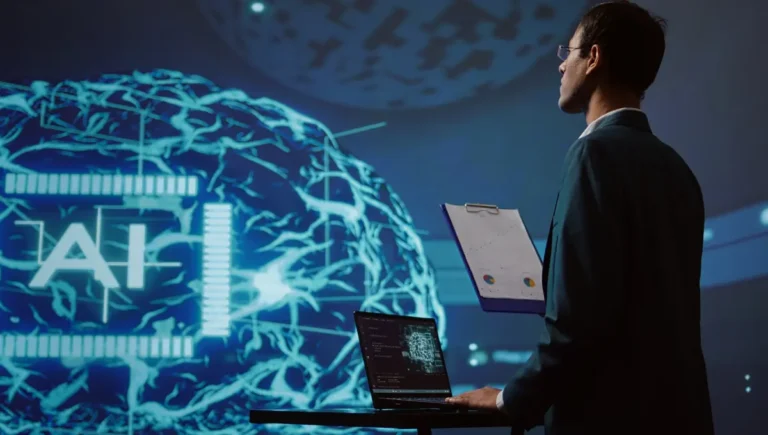Artificial Intelligence (AI) technology is increasingly playing a fundamental role in the security and surveillance industry. Already over 43% of the world’s countries are using AI technology for surveillance and security, including smart city platforms, facial recognition software, and smart policing.
The potential that AI technology shows in offering high accuracy and low-cost surveillance is unmatched. As a result, the use of AI in the industry looks set to grow exponentially over the coming years. For a broader view on current AI trends, check out our article on top AI trends.
AI Surveillance vs. Human Surveillance
The capabilities offered by AI technology regarding security and surveillance simply cannot be matched by humans. For example, humans watching a single video surveillance monitor lose 95% of their ability to discern a critical event within 20 minutes. This decreases to ten minutes if there are two monitors.
Further, humans do not have the capabilities to watch all of the CCTV screens currently installed actively. For this reason, most surveillance cameras are passive. In other words, they record without monitoring, and the footage is available to be reviewed at a later date in the event of an incident.
Passive CCTV is not money well-spent, especially when there is technology available that can actively monitor camera streams in real time, trigger alerts, and ensure a response to an incident in a timely manner. AI-enabled active surveillance provides a higher return on security investment and a more comprehensive level of security.
Company Uptake
The use of AI in the private and public sectors is increasing, with more companies looking to make use of the technology.
Already 71% of security professionals report that AI video analytics adds value to their operations, or they expect it will in the future.
Companies are increasingly looking for innovative ways to use this technology to improve not only security but the overall consumer experience.
Practical Applications
One of the advantages of AI surveillance technology is that it has multiple uses within the security industry. The COVID-19 pandemic saw the technology employed in multiple ways, such as implementing AI-based thermal camera analytics to limit the movement of potentially contagious people.
Companies are increasingly turning to AI for security, with intrusion detection software becoming common in a number of industries, including health, retail, hospitality, defense, and law enforcement.
Machine Learning
To use the volume of data produced by security and surveillance systems to its full potential, systems that are beyond the capabilities of humans must be employed. As a result, both machine learning and deep learning are being increasingly adopted in security solutions.
When humans identify, classify, and determine the properties of different elements, they do so by comparing the current information to previous data they have experienced and stored to make sense of it.
Machine learning adopts a similar approach, except it has the added advantage of being able to compare the information to millions if not billions of different data sets in a relatively short time frame.
This is not an option for humans who do not have the same degree of access to the data sets and the capabilities in terms of the time frame. Put simply; machine learning uses AI to scan through mountains of data, recognize patterns, and learn from those patterns.
Deep Learning
While machine learning requires human intervention from a programmer who will create algorithms and define parameters for AI machine learning, deep learning takes the AI concept to a new level by allowing object attributes to be identified independently.
The result is more comprehensive as often characteristics that programmers may not consider are identified. This technology has resulted in the use of AI in security and surveillance becoming more sophisticated.
Advancements in face recognition and object development have contributed to the increased uses for the technology. However, what makes the use of this technology even more compelling is the 99.3% accuracy that is being recorded.
The applications of this technology will, over time, more than cover the initial investment in the technology. For example, deep learning can prevent a security camera from triggering a false motion detection alarm.
As the technology learns new and different classifications, it can make informed decisions about the movement it is capturing, which ultimately means it can discern the difference between negligible movement and meaningful activity. Ultimately, this creates savings for an organization in terms of negating the need to respond to false alarms.
Practical Example
Law enforcement, perhaps for obvious reasons, is one industry that has embraced the technology, but the potential uses extend well beyond its current capabilities.
The use of AI-based surveillance has the potential to be a breakthrough in preventing mass shootings. For example, AI can differentiate between a holstered gun belonging to a security guard, and an active weapon that is in a “ready-to-fire position. AI systems can also integrate with chemical and audio sensors for comprehensive shooter detection systems, increasing security for organizations of all types.”
Executive Control
AI can increase security and safety for enterprises, operational organizations, critical infrastructure, and law enforcement. Responsible AI vision solution providers will also maintain a careful balance between privacy and socially constructive use of their technology. The security and surveillance options available because of AI technology cannot be matched by humans who do not have the capabilities to process the volumes of data a machine can.
While AI technology is doing the hard work in processing the volumes of data, control over how the information generated is used remains firmly within human hands.
AI security and surveillance platforms represent an opportunity to create a safer environment for everyone. For industry, it offers cost savings and benefits that cannot be replicated by any other means.
Given that technology is still in its infancy, predictions are that the market for AI security and surveillance technology will increase significantly over the coming years as more companies come on board.
Read more: Artificial Intelligence and its Impact on Our Lives




